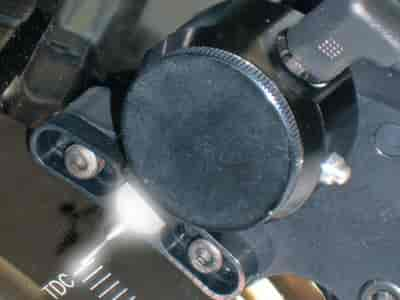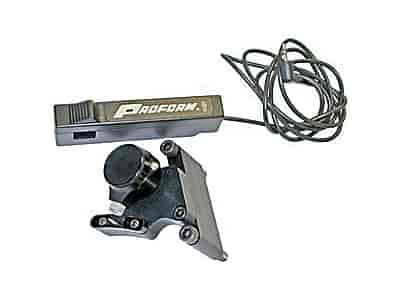IM only too aware that most guys have a timing light or at least know what they are used for and its just not that glamorious, but its a very necessary tool..
There's no question that timing lights are a rather basic tool,and are reasonably easy to use, but theres a great differance in accuracy between differant models.
the basic concept is deceptively simple, get the ignition to light off the compressed cylinder full of that fuel/air mix at the exactly correct instant that will produce the best torque and least wasted pressure working against the piston to drive the rod and spin the crank.
naturally its nearly useless to try and time the ignition until youve carefully verified TDC marks on the damper are correct
To do that you need to know the exact piston location in its repetative 720 degee cycle. by watching the TDC indicator mark on the damper in relation to a timing tab on the timing chain cover.
but accuracy is critical to success, get that ignition to fire a bit early and detonation can cause major problems, if its delayed in relation to the pistons location it will result in less effective pressure and a hotter exhaust header.
Many timing lights are less than consistant or accurate, nore can they give exactly consistant results.
MANY are cheaply constructed and not all that accurate. some won,t work well with solid core wire, some are heat sensitive. the type that allows you to set the timing advance or retard for the flashing strobe light,with a dial are usually not nearly as consistant.
if you own a couple timing lights check them all at the same engine at at least 3000 rpm, and youll comonly see variations in the results and THATS BAD, if its off a couple degrees at 3000rpm, at 6000-7000rpm it can and probably will cause problems, when your engine timing is not even close to what you expect it to be.
The older model Sears Craftsman Timing Light (P/N A-2134) is usually consistant, MSD, makes thier own, timing light (P/N 8990). that is also one of the better ones.
When your using a timing light youll need to verify the battery connections are correct as to polarity, and the wires cant contact moving components like fans, fan belts and pullies, youll need to verify that only the wire from the #1 cylinder contacts the timing lights inductor clip, and that NOTHING contacts the hot headers, and you should NEVER wear a TIE or LOOSE clotheing around a running engine!
obviously getting the ignition timing correct in relation to the compression stroke and piston location in the engine will result in far less chance of detonation and piston damage or loss of potenttial hp, and getting the ignition advance curve correct is also critical, IVE generally found haveing full advance all in by about 2900-3100rpm is a good compromise and while the components used in the engine can change the results, full advance at about 36-38 degrees at 3100rpm is a good basic starting point
There's no question that timing lights are a rather basic tool,and are reasonably easy to use, but theres a great differance in accuracy between differant models.
the basic concept is deceptively simple, get the ignition to light off the compressed cylinder full of that fuel/air mix at the exactly correct instant that will produce the best torque and least wasted pressure working against the piston to drive the rod and spin the crank.
naturally its nearly useless to try and time the ignition until youve carefully verified TDC marks on the damper are correct
To do that you need to know the exact piston location in its repetative 720 degee cycle. by watching the TDC indicator mark on the damper in relation to a timing tab on the timing chain cover.
but accuracy is critical to success, get that ignition to fire a bit early and detonation can cause major problems, if its delayed in relation to the pistons location it will result in less effective pressure and a hotter exhaust header.
Many timing lights are less than consistant or accurate, nore can they give exactly consistant results.
MANY are cheaply constructed and not all that accurate. some won,t work well with solid core wire, some are heat sensitive. the type that allows you to set the timing advance or retard for the flashing strobe light,with a dial are usually not nearly as consistant.
if you own a couple timing lights check them all at the same engine at at least 3000 rpm, and youll comonly see variations in the results and THATS BAD, if its off a couple degrees at 3000rpm, at 6000-7000rpm it can and probably will cause problems, when your engine timing is not even close to what you expect it to be.
The older model Sears Craftsman Timing Light (P/N A-2134) is usually consistant, MSD, makes thier own, timing light (P/N 8990). that is also one of the better ones.
When your using a timing light youll need to verify the battery connections are correct as to polarity, and the wires cant contact moving components like fans, fan belts and pullies, youll need to verify that only the wire from the #1 cylinder contacts the timing lights inductor clip, and that NOTHING contacts the hot headers, and you should NEVER wear a TIE or LOOSE clotheing around a running engine!
obviously getting the ignition timing correct in relation to the compression stroke and piston location in the engine will result in far less chance of detonation and piston damage or loss of potenttial hp, and getting the ignition advance curve correct is also critical, IVE generally found haveing full advance all in by about 2900-3100rpm is a good compromise and while the components used in the engine can change the results, full advance at about 36-38 degrees at 3100rpm is a good basic starting point


